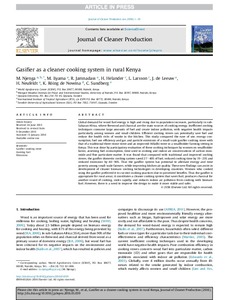| dc.contributor.author | Njenga, M. |
| dc.contributor.author | Iiyama, M. |
| dc.contributor.author | Jamnadass, Ramni H. |
| dc.contributor.author | Helander, H. |
| dc.contributor.author | Larsson, L. |
| dc.contributor.author | Leeuw, Jan de |
| dc.contributor.author | Neufeldt, Henry |
| dc.contributor.author | Roing de Nowina, K. |
| dc.contributor.author | Sundberg, C. |
| dc.date.accessioned | 2019-12-04T10:57:31Z |
| dc.date.available | 2019-12-04T10:57:31Z |
| dc.date.issued | 2016-05-10 |
| dc.identifier.citation | Njenga, M., Iiyama, M., Jamnadass, R., Helander, H., Larsson, L., de Leeuw, J., ... & Sundberg, C. (2016). Gasifier as a cleaner cooking system in rural Kenya. Journal of Cleaner Production, 121, 208-217 |
| dc.identifier.issn | 0959-6526 |
| dc.identifier.uri | https://hdl.handle.net/20.500.12478/764 |
| dc.description | Published online: 17 February 2016 |
| dc.description.abstract | Global demand for wood fuel energy is high and rising due to population increases, particularly in sub-Saharan Africa, where firewood and charcoal are the main sources of cooking energy. Inefficient cooking techniques consume large amounts of fuel and create indoor pollution, with negative health impacts particularly among women and small children. Efficient cooking stoves can potentially save fuel and reduce the health risks of smoke in the kitchen. This study compared the ease of use, energy consumption, fuel use efficiency and gas and particle emissions of a small-scale gasifier cooking stove with that of a traditional three-stone stove and an improved Hifadhi stove in a smallholder farming setting in Kenya. This was done by participatory evaluation of these cooking techniques by women on smallholder farms, assessing fuel consumption, time used in cooking and indoor air concentrations of carbon monoxide and fine particulate matter. It was found that compared with traditional and improved cooking stoves, the gasifier domestic cooking system saved 27–40% of fuel, reduced cooking time by 19–23% and reduced emissions by 40–90%. Thus the gasifier system has potential to alleviate energy and time poverty among small-scale farmers, while improving kitchen air quality. These new findings can assist in development of cleaner biomass cooking technologies in developing countries. Women who cooked using the gasifier preferred it to current cooking practices due to perceived benefits. Thus the gasifier is appropriate for rural areas; it constitutes a cleaner cooking system that saves fuel, produces charcoal for another round of cooking, cooks rapidly, and reduces indoor air pollution from cooking with biomass fuel. However, there is a need to improve the design to make it more stable and safer. |
| dc.format.extent | 1-10 |
| dc.language.iso | en |
| dc.subject | Gasifier |
| dc.subject | Emission |
| dc.subject | Cooking |
| dc.subject | Wood |
| dc.title | Gasifier as a cleaner cooking system in rural Kenya |
| dc.type | Journal Article |
| dc.description.version | Peer Review |
| cg.contributor.affiliation | World Agroforestry Centre |
| cg.contributor.affiliation | University of Nairobi |
| cg.contributor.affiliation | Uppsala University |
| cg.contributor.affiliation | International Institute of Tropical Agriculture |
| cg.contributor.affiliation | Swedish University of Agricultural Sciences |
| cg.coverage.region | Africa |
| cg.coverage.region | East Africa |
| cg.coverage.country | Kenya |
| cg.isijournal | ISI Journal |
| cg.authorship.types | CGIAR and developing country institute |
| cg.iitasubject | Livelihoods |
| cg.journal | Journal of Cleaner Production |
| cg.howpublished | Formally Published |
| cg.accessibilitystatus | Limited Access |
| local.dspaceid | 74387 |
| cg.targetaudience | Scientists |
| cg.identifier.doi | https://dx.doi.org/10.1016/j.jclepro.2016.01.039 |

